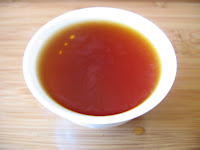Today's post is for Salsero about how I brew my gyokuro.
Gyokuro is the tea that I brew with the most precision. I have found that the factors involved with brewing it vary the flavor so much, and the price on gyokuro tends to be up there to make me not want to eyeball it on the first go.

There are primarily 6 different things that I use to brew gyokuro. From left to right, top to bottom:
1) Thermometer/timer
2) Tokoname kyusu
3) Glass Gong Fu Serving Pitcher
4) Scale, small dish for weighing, and scoop
5) Normal teacup (this is the teacup you see in all the rest of my pictures, but in this one it didn't come out well)
6) Gong fu tasting cup.
To start when brewing a high quality gyokuro I refresh the water in my water kettle, this way it has not been sitting around and losing oxygen content. Once that comes to a boil I fill two of the glass gong fu serving pitchers with water. At this point the water is much too hot to use. I place the thermometer in the pitcher to keep an eye on the temperature.
At this point I normally weigh out my leaf, typically I use 10g / 60mL of tea. That's what the scale, scoop and dish are for. Once I have that weighed out I start cooling the water from one of the pitchers. To do this I rotate the water between the kyusu, teacup, and gong fu cup, and finally back to the pitcher. This allows all 3 of them to all stay warm and preheated. I continue doing this until the water temperature is about 160F. Once the pitcher is around 160F I return all the water from the pot and cups back to the pitcher and wait for it to cool to around 150F. I have heard a large variety of temperatures to use for gyokuro from 120-160F. Unless specifically recommended for that specific tea I use around 150F. I have been experimenting with this temperature though to some degree. I have been finding that cooler tends to produce a better cup of gyokuro, but not always.
Once the water has cooled sufficiently, I add the leaf to the kyusu and begin to add the water to the kyusu. To measure the water I use the gong fu cup because they are approx. 30mL. So two fills of that cup into the kyusu provides me with 60 mL of water in it. Again this amount of water may vary per tea if specifically instructed so. So far most instructions have varied from 30-60mL of water. I typically wait about 60-90 seconds, again depending on the tea, and experimentation to pour off the first cup. I make sure that when I pour the tea into my teacup to get as much of the tea out as I can, typically once most is out I will shake it a bit to get tea out. After that infusion I will reinfuse the tea with another 30-60 mL of water, but this time the infusion time is almost negligible. For this infusion I raise the temperature of the water by 5-10F by adding water from the other Gong Fu pitcher. The temperature change varies according to the taste of the first infusion. If the first infusion is strong then I won't raise the temperature as much, but on a weaker flavor I will up the temperature more. As soon as I add the water I swirl the pot around to allow the leaves (which tend to clump up after the first infusion) to swim around again. Immediately after that I pour off the second infusion.
Successive infusions are done the same way as the second, varying the temperature raising by 5-10F and immediately pouring the tea.
I don't always brew my gyokuro with this level of precision though. Once you try one you start to learn the flavor of that tea and how it reacts, you can experiment more at that point. The main parameters that I change are the amount of water and the temperature of the water. More water tends to give a slightly weaker infusion, but with some gyokuros the flavor is so strong that it could use a bit of lightening up. Higher water temperature brings out more flavor, but as the temperature rises it becomes more like a sencha in flavor. But at the same time not raising the temperature will give you a weaker tea.
So get out there and experiment to what flavor you enjoy the most.
 Tea: Tosa Shimantogawa - 7420
Tea: Tosa Shimantogawa - 7420 1st Infusion: The tea had a very light pale green color to the infusion, with very little aroma to speak of. This was completely different from the flavor though. There was a very strong singular flavor to this tea. It had no aftertaste and very little bitterness. It was a very well defined single flavor. It was a light flavor, but the central part of this flavor was very strong. There was a certain grassiness to the flavor. This cup had me thinking about what it was I was tasting down to the last sip.
1st Infusion: The tea had a very light pale green color to the infusion, with very little aroma to speak of. This was completely different from the flavor though. There was a very strong singular flavor to this tea. It had no aftertaste and very little bitterness. It was a very well defined single flavor. It was a light flavor, but the central part of this flavor was very strong. There was a certain grassiness to the flavor. This cup had me thinking about what it was I was tasting down to the last sip.











































